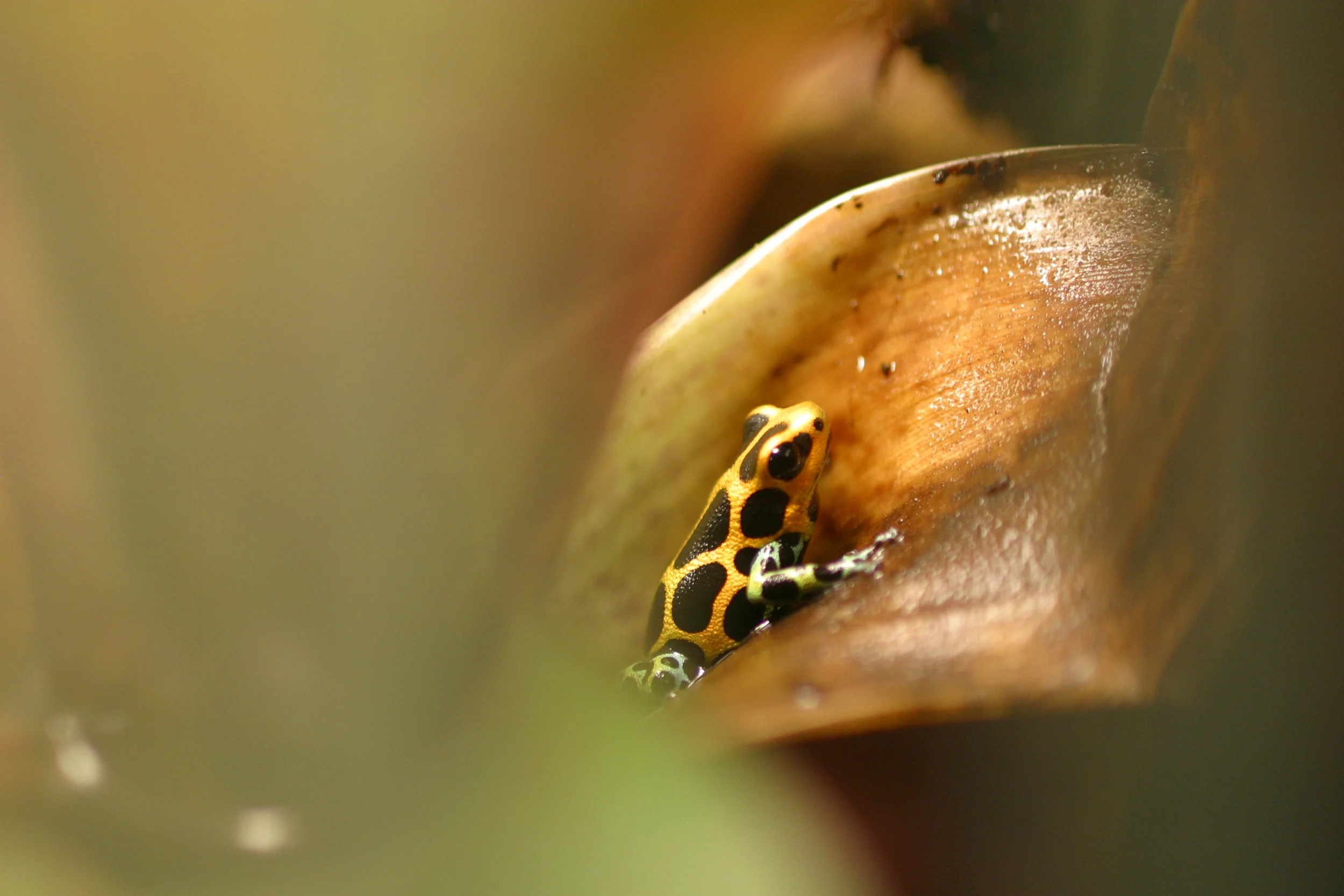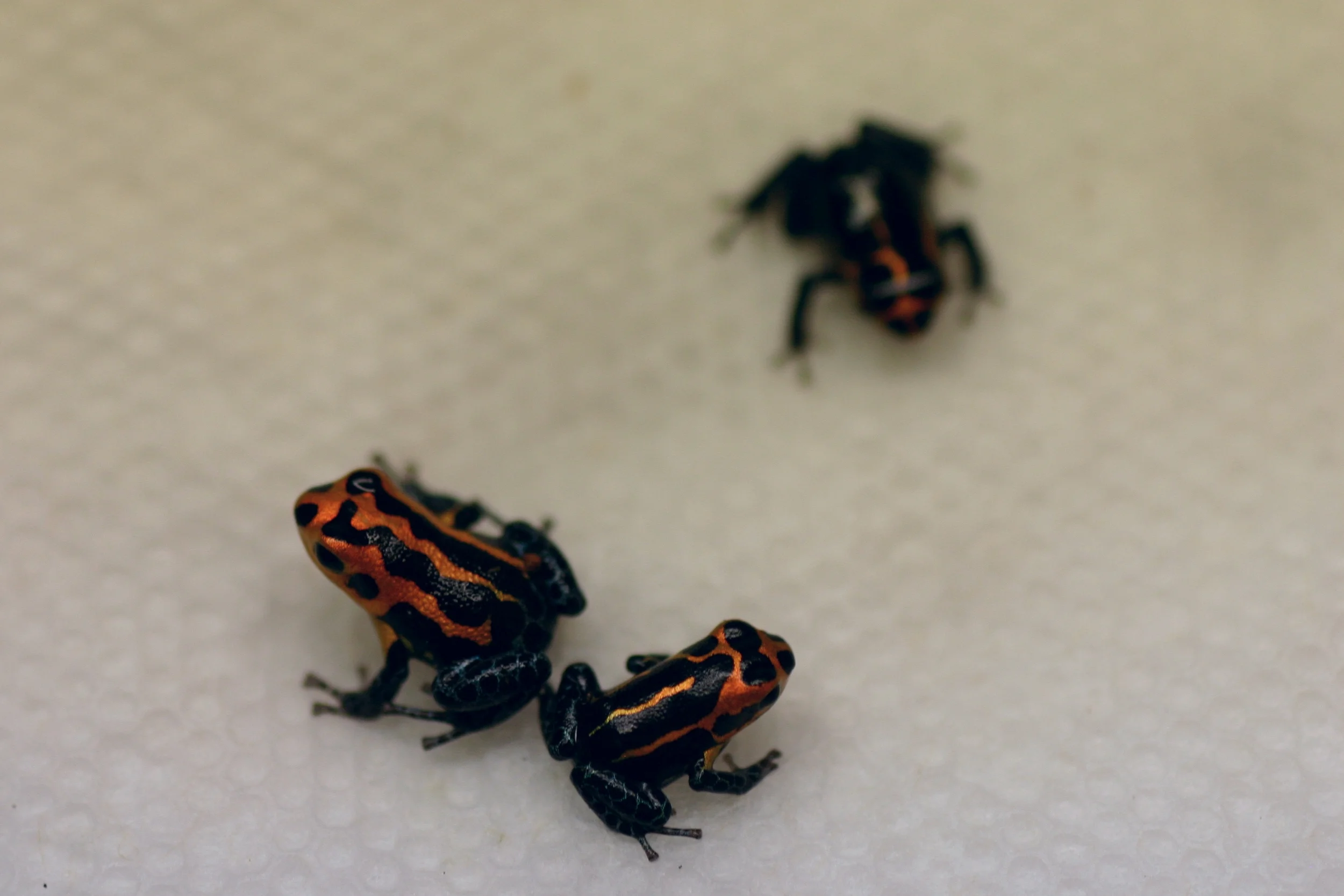



























Your Custom Text Here
My first thumbnail and a fantastic place to start for anyone looking to get into thumbnails. Ranitomeya imitator will breed on just about any protected vertical or near vertical surface. 1-4 (typically 2) white to light gray eggs are laid weekly to every other week. My frogs prefer completely vertical black film canisters with the opening facing down, just above the leaves of plants. Tadpoles hatch in 10 to 14 days and are transported by the male to individual small bodies of water like film canisters or bromeliad axils.
R. imitator take excellent care of their young in captivity and the tadpoles can be left to the care of the adults. If you pull the tadpoles, they need a high protein diet and can be cannibalistic so they are best raised individually. The tadpoles will morph after 60 days and are able to small fruit files supplemented by springtails.
Care: Beginner, typically bold
Groups: No
Breeding: Easy, film canisters upside down vertically
Tadpoles: Excellent parental care after deposition, recommend leaving tadpoles with parents
Froglets: Medium, springtails are a help, tadpoles left with parents morph larger
Tips: Lower light levels result in bolder frogs
My first thumbnail and a fantastic place to start for anyone looking to get into thumbnails. Ranitomeya imitator will breed on just about any protected vertical or near vertical surface. 1-4 (typically 2) white to light gray eggs are laid weekly to every other week. My frogs prefer completely vertical black film canisters with the opening facing down, just above the leaves of plants. Tadpoles hatch in 10 to 14 days and are transported by the male to individual small bodies of water like film canisters or bromeliad axils.
R. imitator take excellent care of their young in captivity and the tadpoles can be left to the care of the adults. If you pull the tadpoles, they need a high protein diet and can be cannibalistic so they are best raised individually. The tadpoles will morph after 60 days and are able to small fruit files supplemented by springtails.
Care: Beginner, typically bold
Groups: No
Breeding: Easy, film canisters upside down vertically
Tadpoles: Excellent parental care after deposition, recommend leaving tadpoles with parents
Froglets: Medium, springtails are a help, tadpoles left with parents morph larger
Tips: Lower light levels result in bolder frogs
Baja Huallaga
This extremely variable morph does not seem to mimic a target species. Frogs range in color from green to orange and have a broken net pattern to bold striping. Melanistic and amelanistic froglets have been produced and these frogs typically breed readily. This morph entered the hobby via Understory Enterprises.
Baja Huallaga
Cainarachi Valley
R. imitator 'Cainarachi Valley' is most likely the same frog as the 'Green' R. imitator, however these frogs were collected with locality data by the INIBICO project. For all practical intents and purposes, treat these frogs just like other imitator just don't mix them with the green imitator in the hobby without locality data.
Cainarachi Valley
Cainarachi Valley
Cainarachi Valley
Cainarachi Valley
Chazuta
These frogs are site specific "Intermedius" that entered the hobby through Understory Enterprises. They breed readily and are typically bold.
Green
R. imitator 'Green' is better known as the nominat imitator in the hobby. This is incorrect as the term nominat refers to the first subspecies described when a species is split into subspecies. Since R. imitator intermedius and R. imitator yurimaguensis are no longer considered valid, these frogs should be referred to as 'Green' or the holotype imitator. These frogs are most likely from Cainarachi, Peru, but since they are of unknown origin they should not be mixed with INIBICO imitator known to originate from that region.
Green
Green
Green - Eggs
Intermedius
While 'intermedius' is no longer considered a valid subspecies of Ranitomeya imitator, it is still used as the common name in the hobby. R. imitator 'Intermedius' is a variable frog patternwise that appears to mimic R. fantastica and R. summersi across it's range. These frogs are similar in care requirements to all other R. imitator.
It is important not to mix these frogs with the ones with locality data from Chazuta and Huallaga.
Intermedius
Intermedius
Intermedius
Tarapoto - Linbo
My Ranitomeya imitator from Tor Linbo's line are some of the boldest frogs I have, being out nearly all the time. These frogs produce offspring with a wide array of patterns, from orange netting like a green imitator all the way to a striped frog, much like a lamasi.
The Linbo Tarapotos should not be mixed with the ones from Understory Enterprises that have locality data linked to them.
Tarapoto - Linbo
Tarapoto - Linbo
Tarapoto - Linbo
Tarapoto - Understory
The Understory line of imitator from Tarapoto, Peru are as fantastic as the Linbo line. Bold frogs that breed regularly, they are typically netted but will produce a range of colors from orange to green. Melanistic and amelanistic froglets have popped up too.
Tarapoto - Understory
Tarapoto - Understory
Varadero
These popular imitators mimic a wicked looking orange fantastica also from Varadero, Peru. Intense orange striping - sometimes covering the whole head - is offset by a black body with blue legs.
Varadero
Yumbatos
Probably the rarest locality of imitator in the US hobby and possibly the rarest legally available thumbnail. These frogs came into the hobby through Understory Enterprises and were not popular at the time. This coupled with limited production in Canada resulted in just a handful of frogs being left in the US. Those that are here haven't produced well. This is all ironic seeing that the striped phenotype is the most common in the wild. These frogs are similar to the Yurimaguensis, however these frequently have more intense striping and are less likely to produce netted offspring.
Yurimaguas
Ranitomeya imitator 'Yurimaguas' used to be considered a subspecies of R. imitator but is now just considered to be a morph. While these striped frogs are not common in US collections, they are actually the most common form of imitator in the wild - like the ones from Yumbatos. The Yurimaguas in the hobby frequently produce netted offspring instead of striped ones. I don't know if this is the result of genetic bottlenecking or something that also happens in the wild.
Yurimaguas